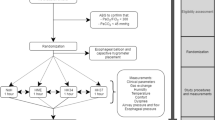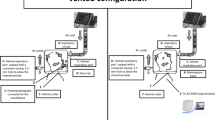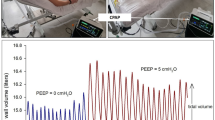Abstract
Purpose: We assessed the performance of different continuous positive airway pressure (CPAP) helmets equipped with a safety valve during discontinuation of fresh gas flow. Methods: This was a physiological study of five healthy volunteers. We delivered CPAP (fresh gas flow 60 l/min, FiO2 60%, PEEP 5 cmH2O) with three different helmets in a random sequence: 4Vent (Rüsch), HelmHAR-cp (Harol) and CaStar CP210 (StarMed). For each helmet we randomly applied, for up to 4 min, three disconnections of fresh gas flow: helmet inlet (Dinlet), flowmeter (Dflowmeter) and gas source (Dsource). We continuously recorded from a nostril: end-tidal CO2 (Pet- CO2), inspiratory CO2 (PiCO2), fraction of inspired oxygen (FiO2) and respiratory rate (RR). Results: During every disconnection we observed an increase in PiCO2 and PetCO2 with a drop in FiO2, while RR did not change. FiO2 decreased more quickly in the CaStar, equipped with the largest safety valve, during Dsource and Dflowmeter, while FiO2 decreased more quickly during Dinlet in CaStar and in 4Vent. PiCO2 resulted in a lower increase in CaStar during Dsource and Dflowmeter compared to 4Vent. PetCO2 in CaStar increases more slowly compared to 4Vent during Dsource and more slowly compared to the other two helmets during Dflowmeter. During Dinlet similar degrees of CO2 rebreathing and Pet- CO2 were recorded among all the helmets. Conclusions: To minimize CO2 rebreathing during disconnection of the fresh gas supply while performing helmet CPAP, it is desirable to utilize large helmets with a large anti-suffocation valve. Monitoring and alarm systems should be employed for safe application of helmet CPAP.
Access this chapter
Tax calculation will be finalised at checkout
Purchases are for personal use only
Preview
Unable to display preview. Download preview PDF.
Similar content being viewed by others
References
International Consensus Conferences in Intensive Care Medicine (2001) Noninvasive positive pressure ventilation in acute Respiratory failure. Am J Respir Crit Care Med 163:283–291
Bellani G, Patroniti N, Greco M, Foti G, Pesenti A (2008) The use of helmets to deliver non-invasive continuous positive airway pressure in hypoxemic acute respiratory failure. Minerva Anestesiol 74:651–656
Taccone P, Hess D, Caironi P, Bigatello LM (2004) Continuous positive airway pressure delivered with a “helmet”: effects on carbon dioxide rebreathing. Crit Care Med 32:2090–2096
Patroniti N, Foti G, Manfio A, Coppo A, Bellani G, Pesenti A (2003) Head helmet versus face mask for noninvasive continuous positive airway pressure: a physiological study. Intensive Care Med 29:1680–1687
Mojoli F, Iotti G, Gerletti M, Lucarini C, Braschi A (2008) Carbon dioxide rebreathing during non-invasive ventilation delivered by helmet: a bench study. Intensive Care Med 34:1454–1460
Antonelli M, Pennisi MA, Montini L (2005) Clinical review: noninvasive ventilation in the clinical setting—experience from the past 10 years. Crit Care 9:98–103
Principi T, Pantanetti S, Catani F, Elisei D, Gabbanelli V, Pelaia P, Leoni P (2004) Noninvasive continuous positive airway pressure delivered by helmet in hematological malignancy patients with hypoxemic acute respiratory failure. Intensive Care Med 30:147–150
Mehta S, Hill NS (2001) Noninvasive ventilation. Am J Respir Crit Care Med 163:540–577
Tonnelier JM, Prat G, Nowak E, Goetghebeur D, Renault A, Boles JM, L’Her E (2003) Noninvasive continuous positive airway pressure ventilation using a new helmet interface: a case-control prospective pilot study. Intensive Care Med 29:2077–2080
Patroniti N, Saini M, Zanella A, Isgro S, Pesenti A (2007) Danger of helmet continuous positive airway pressure during failure of fresh gas source supply. Intensive Care Med 33:153–157
Lofaso F, Brochard L, Hang T, Lorino H, Harf A, Isabey D (1996) Home versus intensive care pressure support devices. Experimental and clinical comparison. Am J Respir Crit Care Med 153:1591–1599
Author information
Authors and Affiliations
Editor information
Editors and Affiliations
Rights and permissions
Copyright information
© 2012 Springer-Verlag Berlin Heidelberg
About this chapter
Cite this chapter
Milan, M. et al. (2012). Performance of different continuous positive airway pressure helmets equipped with safety valves during failure of fresh gas supply. In: Pinsky, M., Brochard, L., Hedenstierna, G., Antonelli, M. (eds) Applied Physiology in Intensive Care Medicine 1. Springer, Berlin, Heidelberg. https://doi.org/10.1007/978-3-642-28270-6_37
Download citation
DOI: https://doi.org/10.1007/978-3-642-28270-6_37
Published:
Publisher Name: Springer, Berlin, Heidelberg
Print ISBN: 978-3-642-28269-0
Online ISBN: 978-3-642-28270-6
eBook Packages: MedicineMedicine (R0)




